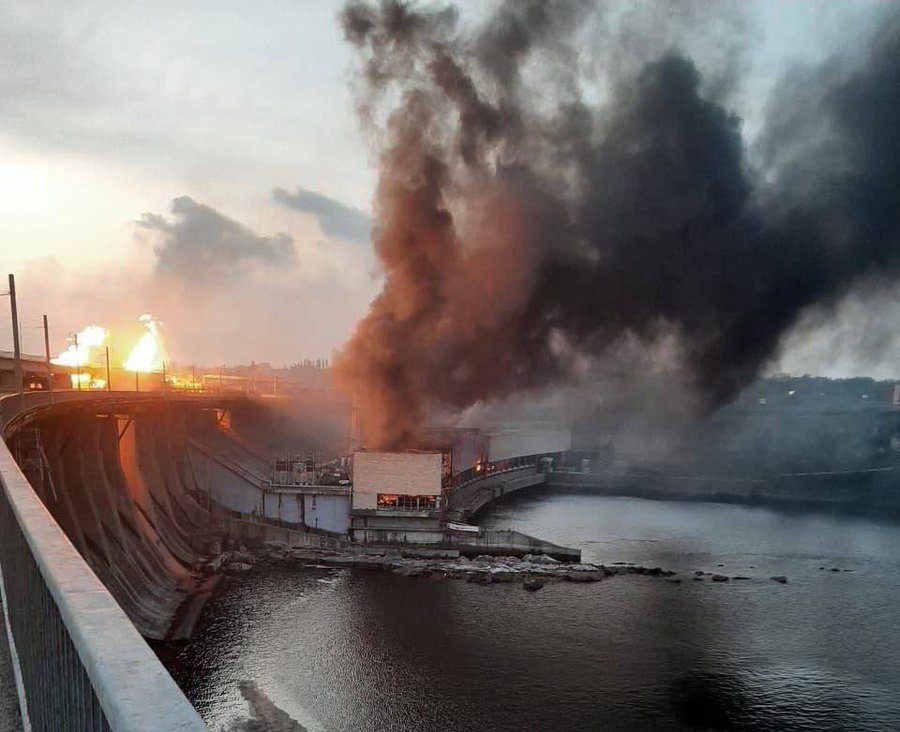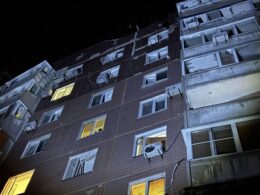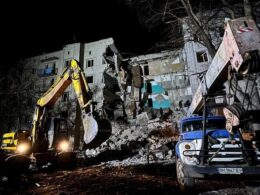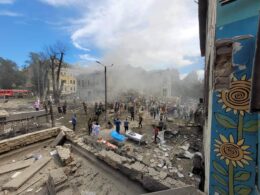Early on 22 March, Russian forces launched a massive air attack on Ukrainian cities using drones, ballistic and cruise missiles. Explosions occurred across multiple regions, hitting infrastructure and causing casualties. The strike disrupted water and electricity supply in places, while also damaging the Zaporizhzhia Nuclear Plant's power line and the Dnipro hydroelectric facility. President Zelenskyy stated that Russia used over 60 Shahed suicide drones and nearly 90 missiles in the attack.
Ukraine's Energy Minister Herman Halushchenko noted that the attack on the energy infrastructure was similar to those that took place last winter:
"The enemy is now launching the largest attack on the Ukrainian energy sector in recent times. The goal is not just to damage it, but to try again, just like last year, to cause a large-scale disruption in the country's energy system."
President Volodymyr Zelenskyy said that Russia had used more than 60 Shaheds and almost 90 missiles during the attack.
"The world sees the targets of Russian terrorists as clearly as possible: power plants and energy supply lines, a hydroelectric dam, ordinary residential buildings, even a trolleybus. Russia is at war against ordinary people's lives. My condolences to the families and friends of the victims of this terror," he said.
The President called on Ukraine's partners to provide Ukraine with additional air defense equipment as soon as possible.
At midnight, Ukraine's Air Force reported on several groups of Russia's Shahed kamikaze drones moving through southern regions.
Later, monitoring channels warned of Russian strategic aviation activity, and at about 03:30 a.m., the Ukrainian Air Force reported launches of cruise missiles from Tu-95MS aircraft, fired from the Caspian Sea area. At about 04:00, a threat of ballistic weapon use from the south was reported, with a MiG-31K aircraft, capable of carrying the Kinzhal aeroballistic missile, taking off at about 04:40. By 04:30, a ballistic missile strike threat on Kharkiv from Russia's Belgorod Oblast was announced.
Kharkiv
In Kharkiv city and oblast, an air raid alert was issued at 03:53. Mayor Ihor Terekhov reported that around 15 explosions were heard in the city by 04:47. He stated that Russia targeted the energy infrastructure, resulting in fires at some of the impact locations.
Residents of the city reported issues with electricity, water supply, and heating after a series of explosions, according to Suspilne. At 05:08, Oleh Syniehubov reported that Kharkiv was essentially left without electricity.
Khmelnytskyi
In Khmelnytskyi Oblast, an air raid alert was announced at 01:01, followed by explosions. Deputy Head Serhiy Tyurin confirmed strikes in the region. Power outages were reported in Khmelnytskyi and nearby areas. Mayor Oleksandr Symchyshyn reported injuries, fatalities, and damaged infrastructure due to the attack. The Khmelnytskyi Regional Military Administration reported one fatality and several injuries from the attack, with search efforts ongoing for people trapped under building rubble.
Zaporizhzhia
In Zaporizhzhia, the first explosion occurred around 4 a.m., with eight strikes reported by regional head Ivan Fedorov at 5:21. A second series of explosions followed at 6:04, bringing the total to 12 missile strikes, resulting in injuries. City Council Secretary Anatolii Kurtiev noted that two detached houses were destroyed, and seven others were damaged, with the condition of the injured being clarified.
Ukraine's nuclear operator Energoatom has reported that the Zaporizhzhia Nuclear Power Plant, temporarily occupied by Russia, lost connection to one of its power lines due to Russian shelling. Currently, the plant is only connected to the "Zaporizhzhia TPP — Ferroalloy" 330 kV power transmission line, having lost its connection with the "Zaporizhzhia NPP — Dniprovska" 750 kV line.
Hydropower operator Ukrhydroenergo reported at 7:40 that Russian forces struck the Dnipro Hydroelectric Power Station (HPP), causing a fire. Emergency services and energy workers were responding, and the situation was under control with no threat of a dam breach.
Odesa Oblast
During a nighttime attack in Odesa Oblast, air defense forces shot down at least 11 drones. As a result of the strikes, there was damage to critical infrastructure objects, reported Natalia Humeniuk, the head of the press center of the Southern Defense Forces, on Ukrainian TV.
Mykolaiv Oblast
In Mykolaiv Oblast, air defense forces destroyed four Shahed 131/136 drones overnight on 22 March. Subsequently, at 05:10, a Russian attack damaged an energy infrastructure facility in the Mykolaiv district. The extent of the damage is currently being assessed, and no injuries have been reported.
Kropyvnytskyi and Kirovohrad Oblast
Explosions were heard in Kropyvnytskyi at 5:21. The Air Forces reported a cruise missile heading towards Kanatove at 05:18, with another missile heading towards the region through Zaporizhzhia reported at 05:00.
Emergency power outages were reported in Bohdanivka village until approximately 8:00 AM, as well as in parts of Znamianka town, Subottsi village, and part of Znamianka city, according to the Znamianka REM Telegram channel of Kirovohrad Oblast. Several districts in Kropyvnytskyi are also without electricity, as reported by Suspilne correspondents. The official channel of the "Kirovohradoblenerho" enterprise announced that power outages were in effect throughout the entire region, according to an order from Ukrenergo.
Dnipro City and Dnipropetrovsk Oblast
In Kryvyi Rih, Dnipropetrovsk region, explosions occurred around 5:05, followed by explosions in Dnipro at 5:14. An air raid alert was issued in the region at 00:56, according to Suspilne
.
Residents report power outages in some parts of Dnipro and reduced water pressure following the explosions. Similar electricity issues were reported in Kryvyi Rih by Suspilne correspondents. Kryvyi Rih Mayor Oleksandr Vilkul indicated that critical infrastructure objects were hit. Vilkul also mentioned that emergency shutdown schedules are being implemented in the city, with hospitals and other infrastructure facilities switching to generators where possible.
Cherkasy Oblast
Air defense systems were active in Cherkasy Oblast on 22 March, with the Ukrainian Air Forces warning of Kinzhal aeroballistic missile threats. Ihor Taburets, head of the Regional Military Administration, reported that aerial objects were detected, air defenses were engaged, and the region remained stable with no consequences.
Poltava Oblast
In Poltava Oblast, Russian strikes damaged houses and caused power outages. Roofs of three homes in the Myrhorod district were damaged, and mobile fire groups were active in the Kremenchuk district. According to Filip Pronin, head of the Poltava Regional Military Administration, there were no casualties, and preventive measures led to power substation shutdowns. He noted that energy workers are restoring power, and resilience points are being set up for residents to charge gadgets and stay connected.
Later, he reported that in the region, more than 104,000 households and 6,700 businesses were without power.
Ivano-Frankivsk
In Ivano-Frankivsk Oblast, a critical infrastructure object was hit during the attack, causing damage, as reported by OVA head Svitlana Onyshchuk. Initial reports indicated that one person was injured.
Lviv Oblast
In the Stryi district of Lviv Oblast, a Russian drone struck an energy infrastructure object, reported regional chief Maksym Kozytskyi. The strike caused a fire, with rescue teams currently responding at the site. There was no information about any injuries at this time.
Read also:
- 13 injured as all 31 Russian missiles aimed at Kyiv downed this morning
- Ukrainska Pravda: Ukraine’s defense intel main target in Russia’s latest missile attack on Kyiv
- Russian missile strike on Mykolaiv kills one, injures eight civilians, including a child





